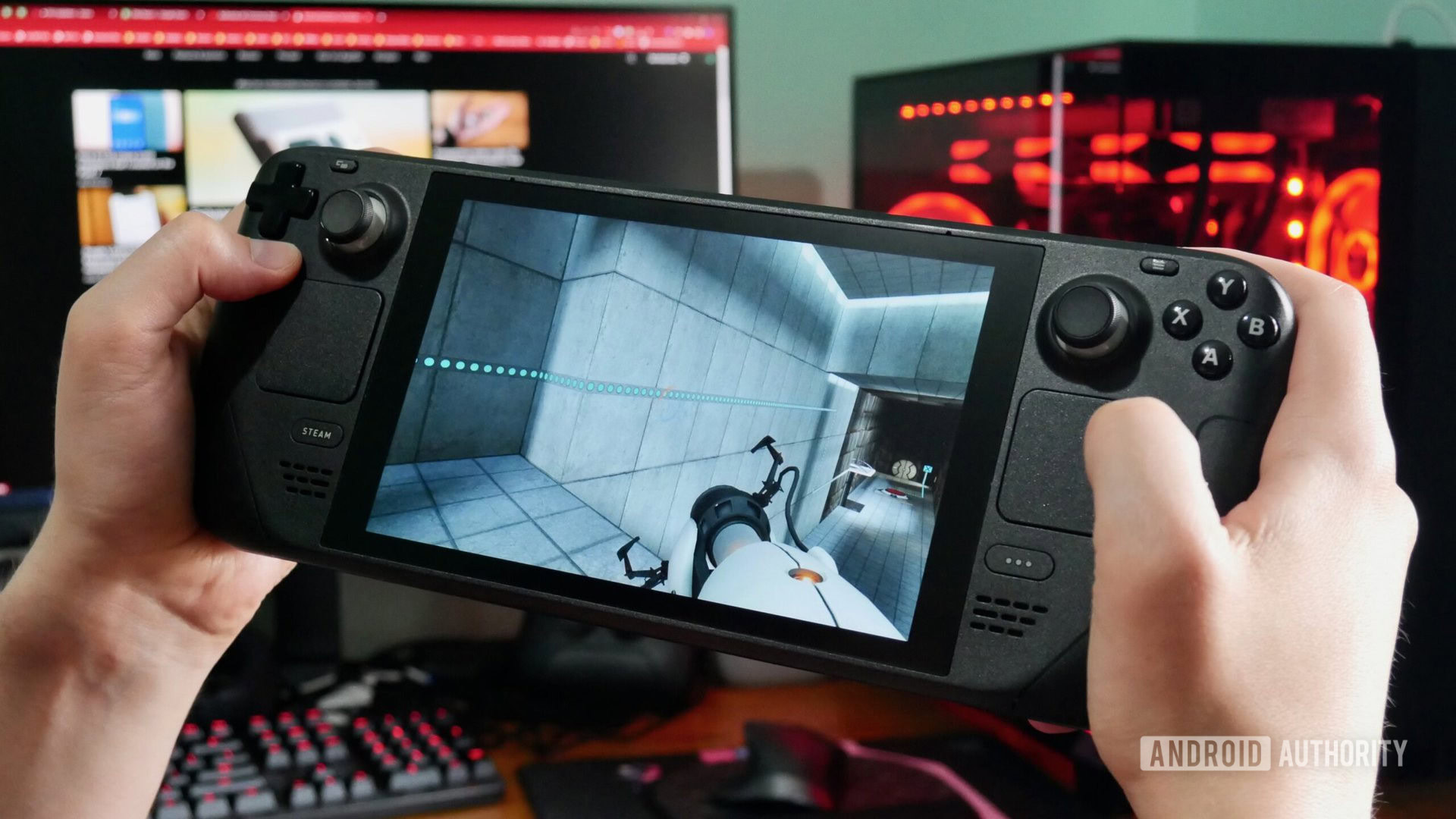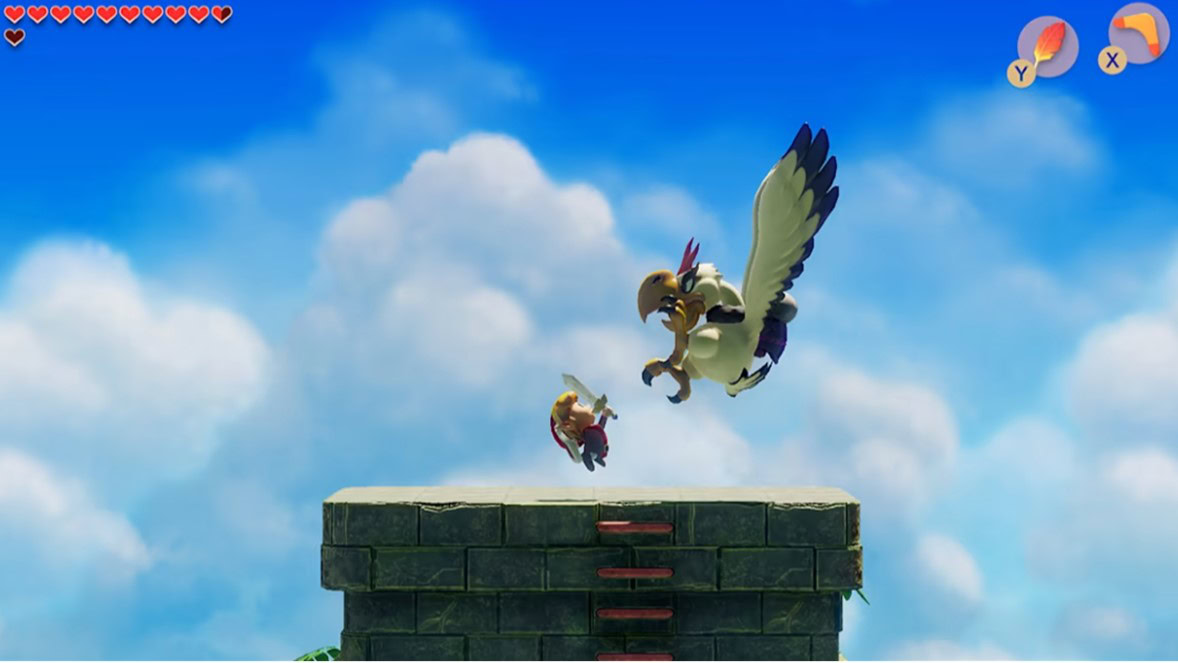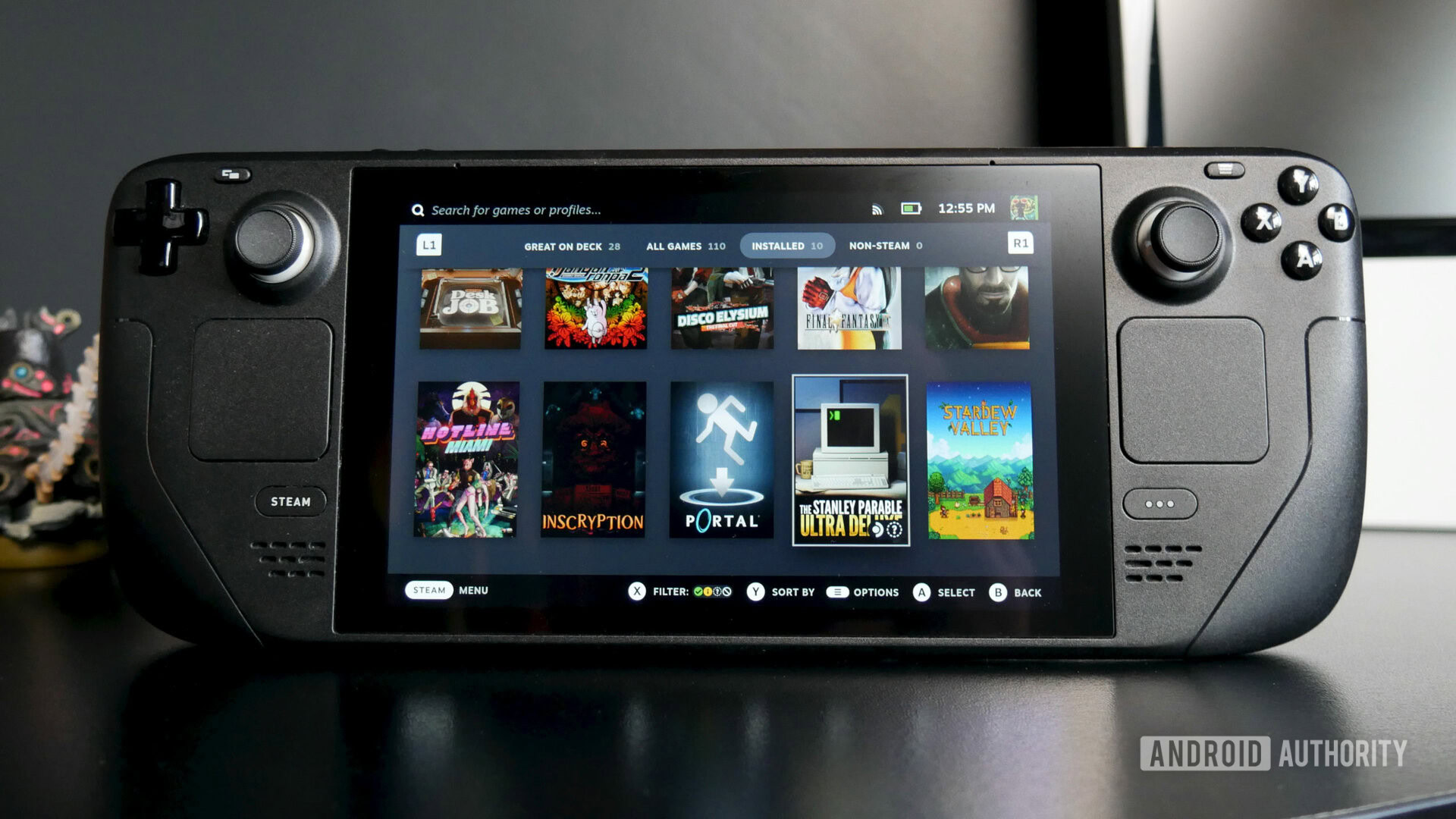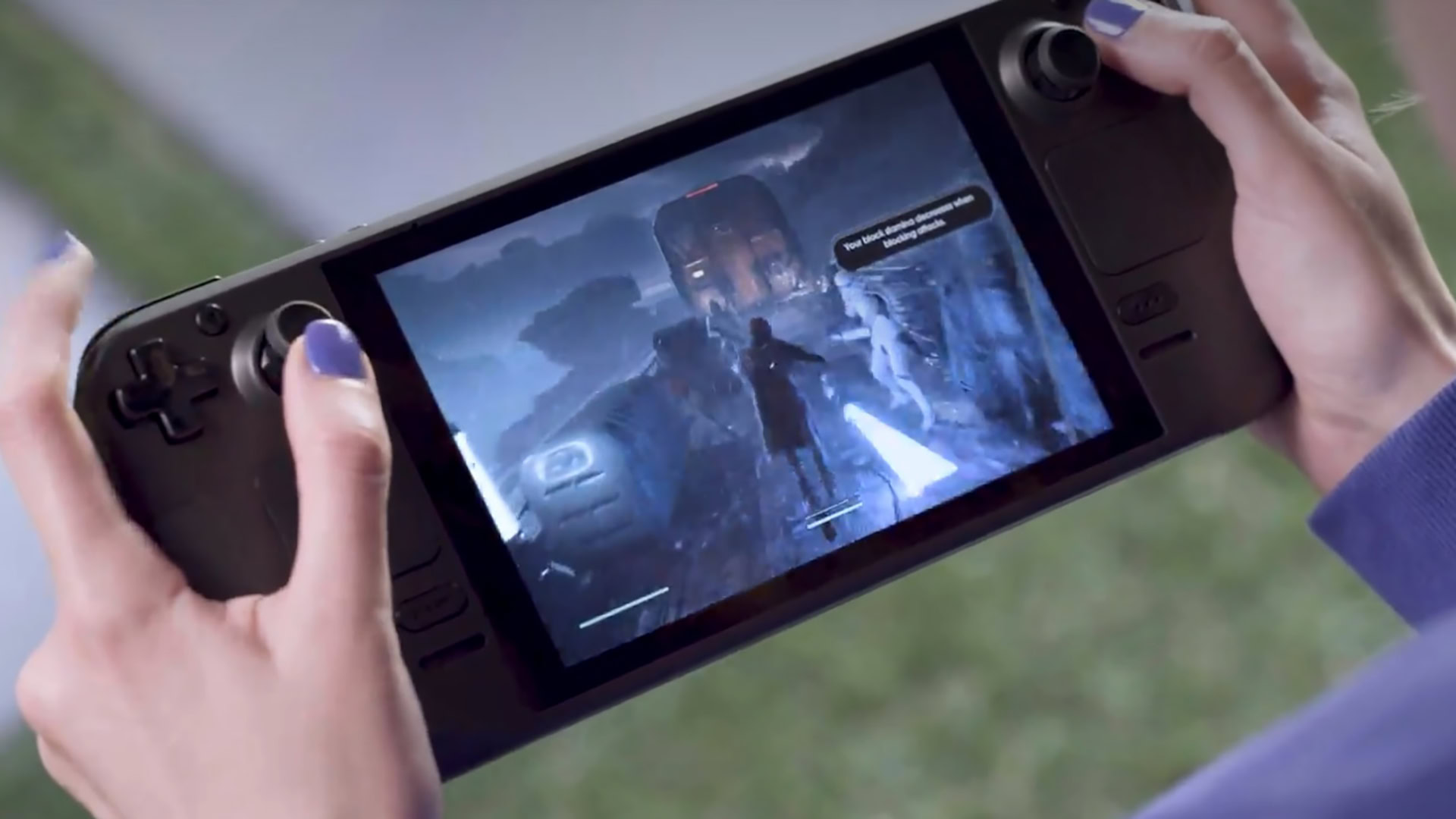
Oliver Cragg / Android Authority
While Nintendo has traditionally reigned supreme in the world of handheld consoles, Valve’s Steam Deck has become a legitimate alternative to the Nintendo Switch. How do the two consoles differ, and which one actually makes sense to buy in 2023?
Steam Deck vs Nintendo Switch: Performance
| Steam Deck | Nintendo Switch | |
|---|---|---|
|
Operating System: |
Steam Deck
SteamOS |
Nintendo Switch
Nintendo Switch OS |
|
Processor(s): |
Steam Deck
AMD Aerith APU system-on-chip |
Nintendo Switch
NVIDIA Tegra X1 system-on-chip |
|
Memory: |
Steam Deck
16GB of LPDDR5 RAM |
Nintendo Switch
4GB of LPDDR4 RAM |
|
Storage: |
Steam Deck
64GB eMMC, 256GB NVMe SSD, or 512GB NVMe SSD (internal), microSD (external) |
Nintendo Switch
32GB (internal, most models) or 64GB (internal, OLED model) eMMC, microSD or game cartridges (external) |
|
Display: |
Steam Deck
7-inch 1280×800 IPS LCD touchscreen |
Nintendo Switch
6.2-inch 1280×720 IPS LCD touchscreen (most models), 7-inch 1280×720 (OLED) |
|
Connectivity: |
Steam Deck
Bluetooth 5.0, 802.11ac Wi-Fi, 1x USB-C 3.2 Gen 2, 1x 3.5mm headphone jack |
Nintendo Switch
Bluetooth 4.1, 802.11ac Wi-Fi, 1x USB-C, 1x 3.5mm headphone jack, 2x Joy-Con connectors, dock (incl. Ethernet for OLED model) |
In terms of performance, there’s almost no contest. The Switch’s Tegra X1 chip, 4GB of RAM, and 32GB of internal storage were sub-par when the console shipped in 2017, and absolutely pale next to the Steam Deck, which shipped in 2022. You can play games like Street Fighter 6 or Cyberpunk 2077 on a Steam Deck — the Switch sometimes struggles with the low-detail (though still attractive) Legend of Zelda: Tears of the Kingdom. Even then you have to slide the Switch into its TV dock to get maximum performance, since it throttles down in portable mode.
The OLED Switch fares marginally better. It gets slightly more internal storage, a more power-efficient Tegra X1 Plus processor, and one of the few things it can lord over the Steam Deck, which is of course its beautiful OLED screen that offers better colors and contrast.
In fact, the only other performance advantage the Switch has is battery life. Standard models get anywhere between 2.5 and 6.5 hours, and going with OLED extends that to between 4.5 and 9 hours. The Steam Deck might not even last 2 hours when playing an intense 3D game like God of War, and isn’t going to run much longer playing less demanding 2D titles. It should be plugged in whenever possible, making the Switch the better choice for long trips.
One thing to factor into a Switch purchase is the absolute necessity of buying a microSD card. 32 or 64GB of internal storage is going to fill up in a heartbeat — Tears of the Kingdom alone consumes 16.3GB.
Steam Deck vs Nintendo Switch: Control

Superficially the two consoles have similar input schemes, including twin analog sticks and an assortment of face, shoulder, and trigger buttons. They’re both well-equipped to play most of the games they run, and when better controllers are needed, it’s relatively easy to buy and connect wired or wireless add-ons. It should be noted that the Switch’s default Joy-Con inputs are removable, although primarily for wireless use, or replacing them if they develop the console’s infamous controller drift.
The Switch is better equipped for multiple local players, since it comes with a TV dock and (in a pinch) a built-in stand for table viewing. There’s nothing blocking similar play on the Steam Deck, but there’s no built-in stand, and you’ll need to buy your own cable or dock to connect it to a TV or monitor.

Oliver Cragg / Android Authority
The Steam Deck does benefit from twin trackpads, which offer more precise control than the Switch for things like strategy and FPS games. And while both systems support using a mouse and keyboard, only the Steam Deck can make extensive use of that, since it’s essentially a handheld PC. Most Switch games won’t work with either peripheral type.
Steam Deck vs Nintendo Switch: Games

For some people, this is going to be the deciding factor over anything else. Many first-party Nintendo games are exclusive to the Switch, and simply can’t be played on a Steam Deck without complicated (and potentially illegal) workarounds. Examples include everything from Tears of the Kingdom and Super Mario Odyssey to Metroid Dread and Pokémon Legends: Arceus. There are third-party games on the platform, but some of those are available elsewhere.
The Switch requires a Switch Online subscription for online play and cloud saves. Among other perks, however, you get a library of classic NES, SNES, and Game Boy titles. The service costs $19.99 per year.

Oliver Cragg / Android Authority
The Steam Deck has a few advantages, including no (inherent) subscription requirement, and access to the massive library of PC titles on Steam. Only some of these are “Deck Verified” — meaning they’re known to play well on the console — but even many non-verified games will work, and the compatibility list is continually expanding.
With some effort, it’s possible to open the Steam Deck to non-Steam titles, including emulators that support many classic console games. In fact, when in Desktop Mode, the only serious barrier to what you can play is the Steam Deck’s specs. The console may be powerful, but don’t expect it to match a desktop PC.
Steam Deck vs Nintendo Switch: Which should you choose?

The answer is complicated. If you want to play Nintendo franchises like Mario, Zelda, or Pokemon, the Switch is pretty much your only choice. When you go that route, however, you’re sacrificing access to many games the Switch is functionally incapable of playing. Titles like Cyberpunk 2077 would be little more than a slideshow on a Switch.
If you’re flexible on the games you’re willing to play, the choice depends on your priorities. People awanting something that can survive a long drive or flight without being plugged in should choose the Switch. That console is also more kid-friendly, both in terms of interface and its game library.
Players after the best possible gaming experience should probably pick the Steam Deck. It’s faster, has more control options, and can potentially access an even larger library than the Switch, since as we’ve said it’s effectively a handheld PC. We’d recommend going with the 256 or 512GB models — 64GB of eMMC is especially limiting in the PC space.
That brings us to a critical topic we haven’t covered yet: cost. The Steam Deck starts at $399, and can cost as much as $649 before adding options like a dock or extra controllers, never mind games. That’s cheap for a PC, yet expensive compared to the Switch, especially if you’re buying something for children to play on.

On Nintendo’s side, the top end is the OLED Switch ($345.99 at Amazon). The older launch model is $299.99, and there’s also the handheld-only Switch Lite ($199.99 at Amazon). That makes the platform pretty affordable, outdated specs notwithstanding.
Something that might balance out hardware costs is game pricing. Nintendo rarely discounts first-party titles, so a product like Super Mario Odyssey is still $59.99, despite being over six years old. Many PC games start at that price or less and frequently go on sale. For people who buy many games every year, a Switch could rapidly become the more expensive pick. That’s without considering the Switch 2, which could ship as soon as 2024. A Steam Deck 2 probably won’t ship until 2025 or 2026, if not later.
Which console do you prefer?
8 votes
FAQs
No. While a Steam Deck should hypothetically be able to run the Windows version, it still won’t run natively or through Proton or Wine. The game’s developer has expressed interest in support, but there aren’t any plans in place.
The Steam Deck doesn’t, although it’s not hard to find free (or at least, free-to-play) games on Steam.
With the Switch, you’ll have to specifically buy a game bundle or Switch Online. Watch out — even the Tears of the Kingdom OLED Switch doesn’t come with the actual game.
There’s a native Switch port of Fortnite.
As for the Steam Deck, there’s no native or Proton support, so you’ll have to install Windows to play, or else use a streaming service like Xbox Cloud Gaming or NVIDIA GeForce Now. Both cloud options require you to install Microsoft’s Edge browser.
Yes. There’s an official Steam Deck Docking Station, or you can use options like a USB-C to HDMI adapter. If your TV has access to the Steam Link app, you can connect to your Steam Deck wirelessly.



